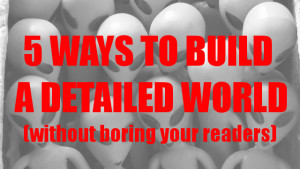A black fedora crouched low over his hooked nose and stiff blonde mustache. He hugged his fraying coat tightly around his body, as if he was afraid it would run off on him, like the second button had. But the really curious thing about the man was the half-carat diamond ring squeezed onto the little finger of his left hand.
Today’s topic comes to us from Alex T., who asks:
I was wondering how to pick how your characters look. I know it isn’t that important, but I’m a little stressed about it.
Oh, but Alex, you’re wrong! Character appearance, done right, is immensely important. It reveals character traits—there’s a reason mad scientists generally have unkempt hair.
Choosing your characters’ appearances is a matter of two things: deciding what you want to reveal about their personalities, and asking yourself the right questions.
- Physical Basics. Eye color, hair color, skin tone, build, age. Also known as the laundry list, this accomplishes very little for you. It allows your readers to picture a kind of doll, but not a person. Know these details (you can choose them based on the character’s ancestry and possibly class), but don’t focus on them. And for heaven’s sake, don’t write a whole paragraph just about the eyes.
- Distinguishing Features. Here’s where we get to the meat. Something noticeable about the character. A misshapen nose, a mole, a gap between the front teeth. This can relate deeply to their past: an old war injury, scars from an abusive relationship, laugh lines, or something they’ve been self-conscious about since birth.
- Type of Clothing. Clothing says a lot about your character’s personality, status, and even occupation. It can also do a lot for your setting. A business suit or space suit? Overalls or miniskirt? Denim jacket or a coat of purple dragon fur?
- Quality of Clothing. Is it old, new, designer, knockoff, handmaid, hand-me-down? And whichever it is, why? Does your character wish he had nicer clothes, or does he just not care? This says something about your character’s present and past. A man in expensive but old clothes may have lost a fortune. A girl in ill-fitting fashions from the last decade might be wearing something passed down from older sisters.
- Presentation. Is your character neat or sloppy? Pressed and buttoned or wrinkly and disheveled? A rich tomboy might wear expensive stockings covered in runs and grass stains. A poor but ambitious man might wear a second-hand suit that is always painstakingly pressed.
- Poise. Think about Heath Ledger’s Joker or Tony Shaloub’s Monk. Mannerisms make a huge difference in a character appearance and speak a lot to state of mind. Do they slouch, or stand straight, or point their nose in the air? Do they limp or shuffle or glide or skip? A confident person will stand tall and look straight at you. An anxious person might fidget and look at the floor.
One Final Rule of Thumb:
Don’t describe every detail. You are not reporting to a police sketch artist; you are giving your readers an impression. Pick a few key details and let your readers fill in the rest.
For instance, without looking back at the description at the beginning of this post, can you remember the color of the man’s coat? Black or grey, right? Right. Only, I never said what color it was. I gave you the color of the hat, but that detail allowed you to make an assumption about the coat, and probably the pants and shoes, too.
–
Now that you know what your characters look like, here’s more help with describing them.
Writing in first person? Here’s how your narrator can describe himself.
Need help building your protagonist? Maybe you need to find his voice! Join us for Voice Week, September 22-26.
Got your own writing question? Drop it in the Suggestion Box.

6 Elements of Character Description that Go Way Beyond Eye Color








